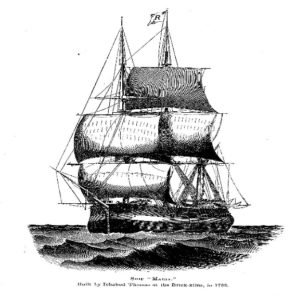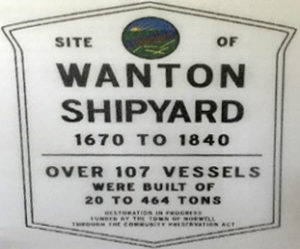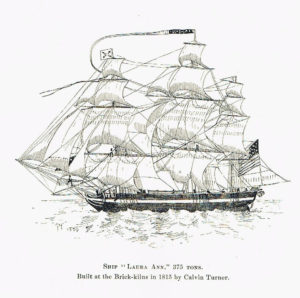 This is a reprint of an article that appeared in the following newspapers: Pilgrim County Press, Duxbury Pilgrim, Marshfield Mail, Cohasset Cottager, Hanover Advance, Pembroke Colonist, Abington Advertiser, Scituate Herald and Norwell News
This is a reprint of an article that appeared in the following newspapers: Pilgrim County Press, Duxbury Pilgrim, Marshfield Mail, Cohasset Cottager, Hanover Advance, Pembroke Colonist, Abington Advertiser, Scituate Herald and Norwell News
Friday, December 19, 1919
The River of a Thousand Ships
By Henry T. Claus
Transcribed and edited by Jane Estabrooks, June 2019
North River – our own North River is no longer to go unheralded and unsung. At ten places along its winding course from Hanover to the Sea impressive metal markers will be placed as reminders to the South Shore traveler that he is in a district whose shipyards in their day turned out more than a thousand vessels and which a century or so ago was renowned the world over as the home of sturdy ships and sturdier sailors, writes Henry T. Claus in a recent issue of the Boston Transcript.
There were, of course, at one time or another more than ten shipyards on North River. Eventually the sites of nearly all of them will probably be marked, but immediate plans call for tablets only at the more important ones. The work of placing the markers has been undertaken by a group of men who are interested in memorializing the shipbuilding traditions of the region and have formed the North River Historical Association with the following officers: Luther Little of Sea View, president; Hugh Bancroft of Boston, vice president; J. S. Hathaway, 930 Commonwealth Avenue, Boston, secretary and treasurer; Roger S. Dix, Alfred L. Lincoln and Edmund Q. Sylvester, executive committee. The association numbers among its members many men with strong South Shore affiliations.
Within a few weeks the sites of the following yards will be marked with tablets similar to the one reproduced on this page:
- Wanton’s, 1670 to 1840, where more than 107 vessels of 20 to 464 tons were built.
- Roger’s 1790 to 1820, more than 23 vessels of 20 to 231 tons.
- Briggs’ at Hobart Landing, 1645 to 1842, more than 69 vessels of 16 to 400 tons.
- Smith’s, later Barstow’s Lower Yard, 1789 to 1846, more than 71 vessels of 27 to 388 tons.
- Block House, 1701 to 1834, more than 51 vessels of 51 to 365 tons.
- Chittenden’s, 1690 to 1871, more than 71 vessels of 20 to 31 tons.
- Brick-Kiln, 1730 to 1848, more than 121 vessels of 15 to 375 tons.
- Fox Hill, 1690 to 1848, more than 56 vessels of 20 to 390 tons.
- Barstow’s Two Oaks, 1792 to 1838, more than 22 vessels of 37 to 340 tons.
- White’s Ferry, 1705 to 1839, more than 40 vessels of 21 to 395 tons.

Later on also it is the purpose of the association to furnish each of its members with a small map of the river between the bridge just below Hanover Four Corners and the ocean. This map which is now being prepared by Edmund Q. Sylvester, will indicate just where the old shipyards were located and where the markers have been placed. The association has some other plans in view and asks the cooperation of those interested in its work. A larger membership list and more available funds will enable it better to carry out its purposes.
To Be Continued . . . .
